They are the witnesses to the suffering on Earth. To mark its 50-year anniversary, the world-renowned NGO Doctors Without Borders (MSF) has joined forces with the Magnum photo agency to bring their photographic material on global crises past and present it into one collection. Witnesses: 50 Years of Humanity offers an extensive online exhibition.

You’re getting blind.
Don’t miss the best of visual arts. Subscribe for $9 per month or $108 $90 per year.
Already suscribed ?
Read more: Jacob Ehrbahn: On the Roads of Exile



